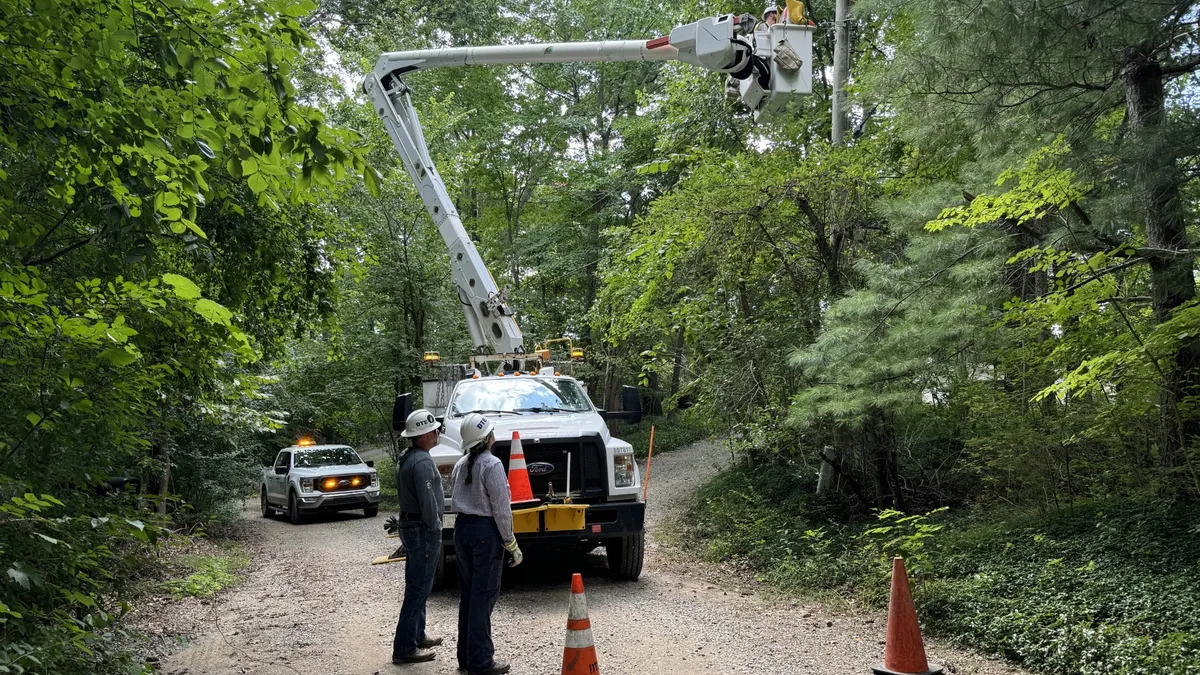Dive Brief:
- DTE Electric and Consumers Energy are each “worse than average” when it comes to power outage restoration times, and both utilities are behind on their intended vegetation management cycles, according to an audit published Monday by the Michigan Public Service Commission.
- The audit was performed by The Liberty Consulting Group, which will present its findings to the PSC on Thursday. The examination of the utilities’ operations “will inform our next steps and strategies to make the electric grid more resilient and reliable,” Commissioner Katherine Peretick said in a statement.
- Both utilities say that they are working to improve reliability. DTE said it aims to reduce power outages by 30% and cut outage time in half by 2029, while Consumers said it has a “blueprint for fewer and shorter outages including no customer going more than 24 hours without power.”
Dive Insight:
The PSC ordered the audit in 2022 following “a pattern of widespread, lengthy outages from increasingly severe storms.” In August 2022, storms left nearly 500,000 customers without electricity for up to several days, and a 14-year-old girl was killed and two boys were critically hurt by contacting power lines downed in the storm, according to the commission.
DTE and Consumers serve a combined 4.1 million customers.
The audit is “an incredibly valuable tool as the [commission] continues its work to reduce power outages, shorten the time for restoration of power after storms, and keep residents safe when power lines come down,” PSC Chair Dan Scripps said in a statement. “The audit underscores that now is the time for both companies to focus more on strategic investments to prevent outages rather than reacting to them.”
Liberty spent more than a year performing the audit, which included assessing the utilities’ infrastructure, programs and processes, inspecting poles and wires and substations, and examining records, according to the PSC. The consulting firm held about 150 meetings in the process of completing its review, including 50 interviews at each company.
The review “provides unprecedented transparency into the utilities’ infrastructure and operations and allows us to make better decisions to improve service and affordability for Michigan customers,” Peretick said.
The audit of DTE’s system found:
- DTE’s 2022 and 2023 Customer Average Interruption Duration Index metric, or CAIDI, was in the 4th quartile compared with other utilities, both when including and excluding major weather events, and is “worse than average among utilities”;
- Almost 45%, or about a million of DTE’s customers, are served by an ungrounded 4.8-kV system that slows restoration time relative to 8.3-kV and 13.2-kV systems “and exposes employees and the public to possible shock hazards when downed 4.8 kV live wires occur”;
- The utility’s infrastructure is aging. Roughly 40% of DTE’s circuit breakers and reclosers were installed between 1930 and 1960 and about 20% of DTE’s subtransmission and 28% of its distribution poles were installed more than 60 years ago; and
- DTE aims to perform vegetation management on its lines every five years, but the effective cycle is currently five to seven years.
The audit also noted that DTE “does not track the ages of its service transformers,” and it “does not accurately track in many cases the customers served by service transformers.”
In order to limit outages and improve restoration times, DTE said it has been “making significant investments as part of our accelerated plan to quickly transition to a smarter grid, aggressively trimming trees, updating our existing infrastructure and rebuilding significant portions of the grid.”
“We are always looking for ways to improve our processes and programs,” DTE said. The utility will file a formal response with regulators and said it looks forward to working with the PSC “on ways to provide our customers with cleaner, more reliable, and affordable energy.”
The audit of Consumers’ system found:
- Consumers’ 2022 and 2023 CAIDI metric, both including and excluding major weather events, was in the 4th quartile and is “worse than average among utilities”;
- The utility’s system operates at a variety of low distribution voltages, due to the merger of legacy utilities over the years. It is “an unusual circumstance that poses material challenges,” Liberty Consulting said;
- More than 60% of Consumers’ low-voltage distribution poles are classified as small-diameter and are more susceptible to breaking in storms; and,
- The utility targets a vegetation management cycle of five to nine years, depending on circuit voltages, for an average of seven years, but its current average effective cycle is nearly 10 years.
The audit also noted Consumers uses broad categories of “Weather” and “Unknown” to indicate the cause of power outages, which “is not precise and masks the actual cause of outages.”
The audit “has been constructive, and we appreciate the deep experience and expertise Liberty brought to the process,” Katie Carey, Consumers’ director of external relations, said in an email.
“Michiganders are facing more severe and frequent storms, which is why we announced our Reliability Roadmap in 2023, a blueprint for fewer and shorter outages including no customer going more than 24 hours without power,” Carey said. “Our investments are focused on the customers we serve by adding technology, burying power lines and clearing trees.”
It will take time for both utilities to make the necessary investments to improve reliability, Commissioner Alessandra Carreon said.
“The data from this audit will help shape strategies to prioritize the deployment of the investment needed to reduce outages from severe weather, restore power faster when it goes out, and significantly lower the risk of the public coming in contact with downed power lines,” she said.















